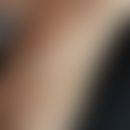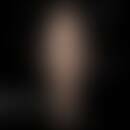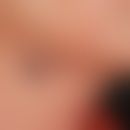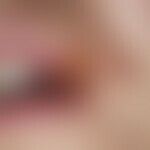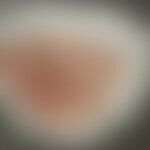Synonym(s)
Go toThis section has been translated automatically.
S.a. u. Herpes simplex virus infections
DefinitionThis section has been translated automatically.
Mostly contact infection, rarely droplet infection, caused by the herpes simplex virus -1. S.a.u. Herpes viruses, human (herpes from Greek herpein = to crawl). The viruses prefer the transition area between skin and mucous membranes. Small defects in the epithelium of the skin or mucous membranes serve as ports of entry. The frequent recurrences of the disease are caused by edogenic reactivation of the viruses. They often affect the same site(herpes simplex recidivans). Up to 40% of the population suffer from recurrent herpes simplex labialis.
You might also be interested in
Occurrence/EpidemiologyThis section has been translated automatically.
Oral HSV-1 infection is still extremely common and is one of the most common viral infections in humans worldwide. According to the WHO, an estimated 3.7 billion people under the age of 50 (67%) are infected with HS V-1 worldwide (Billions Worldwide Living with Herpes.
In the United States of America (USA), 57 % to 80 % of adults are affected by HSV-1, while in Asia the numbers are much higher in adults (75 %), especially in people from low socioeconomic backgrounds, and in children (50 %) due to epidemiological shifts showing lower seroprevalence in young cohorts (Khadr L et al.2019).
A 2016 estimate found that approximately 3.583 billion people were infected with oral HSV, representing a prevalence of 63.6%, with the majority coming from the Southeast Asia region, followed by the Western Pacific region. Recurrent herpes labialis (RHL) has been reported to affect approximately one-third of the population in the US, presenting as inflamed/painful oral lesions with conditional distress. Some patients usually experience up to six episodes per year, which can be very distressing for patients and their families.
Overall, the average incidence of recurrent herpes labialis (RHL) is around 1.6 per 1000 patients per year with a prevalence of 2.5 per 1000 patients, but varies considerably between countries and different communities, including a greater incidence in women, where an estimated one third of all affected patients experience at least one episode per year (Rani SA et al. 2021).
In a similar study in Sweden, the number of lifetime encounters with symptomatic herpes labialis among 3597 participants was about 40%. A cross-sectional survey of American college students found a prevalence of HSV-1 antibodies of 37.2% in first-year students and 46.1% in final-year students, indicating a decline in HSV-1 seroprevalence from 62.0% (1988 to 1994) to 57.7% (1999 to 2004) (Gibson JJ et al. 1990).
EtiopathogenesisThis section has been translated automatically.
The majority of primary infections occur through direct contact with body fluids such as saliva or exudates from advanced lesions as well as through direct contact with lesions of infected persons. In addition, the virus can also be transmitted by kissing or sharing towels or utensils. The primary infection usually occurs between 2 and 20 days after contact. Around 2-10% of these infections also affect asymptomatic patients who shed HSV in their saliva at regular intervals, which is particularly pronounced in immunocompromised people, with an estimated 38-40%. Asymptomatic HSV shedding is mainly seen in the prodromal phase after infection and 60% of these patients do not develop vesicles even with the usual symptoms of fever and pain.
At the site of contact, HSV-1 primary infections are triggered after viral penetration into the tissue and fusion of the viral envelope with the epidermal and dermal cell membranes (epidermal and mucosal). Infection of the skin or mucous membranes is accompanied by inflammation and tissue damage, resulting in the characteristic herpes blisters. After efficient replication in epithelial cells, HSV reaches the nerve endings of peripheral neurons and is transported retrogradely into the neuronal cell body. The immune system injury disrupts the host cell's response to viral suppression, so that the immune response is bypassed by the complex interaction of the virion protein, also known as "virion-host shutoff".
PathophysiologyThis section has been translated automatically.
HSV often leads to either a lytic or latent infection. During latency, there is minimal gene expression and no viral particles are formed. The viral genome is capable of reactivation, leading to the production of infectious virions in response to the right stimuli. Sensory neurons harboring the virus contain nuclear transcripts known as latency-associated transcripts (LATs ), which are responsible for modifying the chromatins of the viral genome, resulting in stable but reversible silencing of the HSV genome. LATs are approximately 8.3 kb long non-coding RNA expressed in the nucleus of latently infected cells (Cabrera JR et al. 2018). Under latent conditions, LATs remain highly expressed and suppress the expression of immediate early (IE) genes, which are among the most important genes in the lytic cycle (Cabrera JR et al. 2018). LATs play a role in protecting latently infected neurons from apoptosis by epigenetically modifying histones to regulate the expression of latent genes (Perng GC et al.2000). HSV infection in the body of neurons usually results in infectious viral particles, whereas infection on axons does not produce infectious particles, especially when the infection titer is low. During reactivation, new infectious virus particles are formed in the infected neurons. These particles migrate anterograde to the skin or mucous membrane and produce classic herpes blisters. The virus can potentially invade the CNS, including the brain, and cause encephalitis or meningitis in immunocompromised patients. Recent studies have shown that HSV-2 reactivation is very common, e.g. in the vaginal mucosa of asymptomatic patients (Gopinath D et al. 2023).
Trigger:
- Fever: One of the most common triggers for recurrent herpes labialis (RHL) is fever. RHL occurs three times more frequently in patients with febrile illnesses than in patients without these illnesses. Furthermore, the frequency of recurrence could also coincide with the expression of numerous candidate genes, namely human chromosome-21 (C21) or the cold sore susceptibility gene-1(C21orf91 gene)( Kriesel JD et al. 2014). Previous studies have identified a total of 6 candidate genes that influence herpes susceptibility. The C21orf91 gene is actively associated with symptoms such as fever and the development of blisters via an unknown mechanism (Grinde B 2013).
- UV: Sunlight, or UV light in particular, is also an important and frequent trigger factor for RHL. Susceptible individuals such as swimmers, fishermen, farmers or skiers are exposed to sunlight for prolonged periods and typically show herpes eruptions after 3 to 5 days. The administration of prophylactic acyclovir to HSV-1-seropositive skiers can prevent the reactivation of latent HSV-1 (Spruance SL et al. 1988). UVB-sensitive individuals are also more susceptible to recurrent herpes labialis infections (Taylor JR et al. 1994).
- Zinc deficiency: Zinc deficiency also appears to lead to prolonged episodes in HSV-1 patients. The presence of zinc dramatically increases the number of effector and helper T cells, which subsequently form antibody precursors and contribute to the suppressive functions of the responsible cells [Barman N et al. 2016). Kamakura et al. observed that upregulation of the zinc finger transcription cell protein, known as insulinoma-associated-1 factor, led to an increase in immunity-related phagocytic activities to stop viral replication and boost the local immune system (Kamakura M et al.2011). Thus, it is clear that zinc supplementation is beneficial for individuals suffering from herpes whose T cell function is impaired due to zinc deficiency. Topical treatments with zinc oxide creams in combination with glycine can achieve considerable success in herpes infections on the face and body surface with or without undesirable side effects (Godfrey HR et al. 2001).
- VitaminD: Another crucial element is vitamin D, which has similar immunomodulatory properties to zinc, and low serum levels have been shown to coincide with the recurrence of cold sores; further research is needed to determine the actual mechanism (Gopinath D et al. 2023).
- Stress. Another important factor contributing to the reactivation of the virus is increased levels of psychosocial stress. A meta-analysis including several psychosocial and emotional assessments reported reliable positive correlations between chronic stress and recurrence of HSV-1 infection with clinical symptoms (Chida Y et al. 2009). Suppression of the immune system, which allows viruses to evade immune surveillance, is thought to be the mechanism by which these stressors influence the severity and recurrence of HSV disease. However, many HSV-infected neuron types, including sensory and autonomic neurons, selectively express the receptors for the two major stress hormones adrenaline and cortisol. It is possible that autonomic neurons play a unique role in the stress-induced modulation of productive HSV infection, as the stress hormones adrenaline and cortisol have differential effects on HSV DNA replication and the release of infectious viral particles(Ives AM et al.2017). However, the exact mechanism is not yet known. CD8+ T cells have been shown to play an essential role in suppressing the modulated immune functions caused by psychological stress and in preventing the reactivation of latent viruses.
- Immunodeficiency: Immunocompromised hosts have a longer duration of episodes and are more susceptible to infectious spread and comorbidities, especially those undergoing bone marrow or organ transplantation, chemotherapy or dialysis. Although herpetic keratitis or encephalitis are rare, these complications are the result of severe or untreated HSV-1 infections. In a study of Caucasian ethnicity, decreased lymphocyte counts were found to be associated with herpes labialis, suggesting that changes in white blood cell differentials are responsible for the risk of HSV-1 reactivation (Oakley C et al 1997). In addition, HSV-1 infection in immunocompromised individuals is considered "atypical" as they show a greater degree of damage and aggressiveness, slower recovery (median recovery time up to 28 days) and a higher degree of pain compared to immunocompetent patients. In addition, co-infections with CMV and other viruses are common in immunocompromised patients.
ClinicThis section has been translated automatically.
HSV primary infection (pathogen mostly HSV-1, rarely but increasingly: HSV-2):
- Asymptomatic primary infection (>90% of cases): it is mostly not noticed.
- Symptomatic primary infection: Uncharacteristic prodromal stage with tightness, itching or pain, rarely fever and swelling and painfulness of the draining lymph nodes (cervical lymph nodes). Solitary or grouped, 0.2-0.4 cm large, initially clear, tense vesicles appear on reddened and swollen lip skin. In the further course, clouding of the vesicle contents, erosions or ulcerations and yellowish crusts. Healing in uncomplicated courses usually after 5-10 days.
- Complicative primary infection (<1% of primary infections): In a few cases, the initial manifestation leads to a clinically severe infection of the oral mucosa and the perioral region with the appearance of gingivostomatitis herpetica or its maximum variant, the aphthoid Pospischill-Feyrter.
Latent HSV infection:
- In this infection phase, the patient is asymptomatic, but can excrete viruses and is therefore infectious.
Recurrent infection (HSV persists in the ganglion gasseri of the trigeminal nerve and is reactivated by various stimuli, see alsoherpes simplex virus):
- S.u. Herpes simplex recidivans: Most frequent manifestation of a herpes simplex virus infection (usually recurrence) on skin or mucosa in the form of mostly chronic recurrent eruptions of grouped standing pinhead-sized vesicles.
- Reactivation of the viruses usually occurs without any apparent reason, but also after various irritations (UV radiation). Irritations (UV irradiation = herpes simplex solaris; trauma (herpes simplex traumaticus) (physical or psychological stress; infections of other genesis).
- A massive, extensive spread of a herpes simplex virus infection in atopic eczema is called eccema herpeticatum.
- A dreaded infection of the eyes is herpes simplex corneae.
Differential diagnosisThis section has been translated automatically.
Physical trauma: Bite wounds usually lead to deeper injuries. Also missing is the typical medical history of recurrent herpes simplex infection.
Corner of the mouth rhagades: in children and adolescents with cheilitis simplex or atopic eczema. Elongated tears of the corners of the mouth with eczema. Long term (several weeks) continuous course.
Perlèche: rather long, continuous course with weeping and crust formation in the area of the corners of the mouth (rather untypical localization of the herpes simplex infection)
Syphilis: syphilitic papules occurring in the context of early syphilis. Miest appearing in the area of the corners of the mouth. Observe the overall constellation (exanthema, always positive syphilis serology)
Herpes zoster: rarely occurs as a circumscribed manifestation in red lips. Not recurrent. Segmental infestation.
TherapyThis section has been translated automatically.
see below Herpes simplex infections (overview)
Phytotherapy externalThis section has been translated automatically.
Additional local therapy with lemon balm leaves (Lomaherpan® cream), initially applied 4 x / day, then 2-4 x daily. Also suitable for prophylaxis and care - here there is a combination of lemon balm leaves with additional sun protection factor 30 (Lomaprotect ®)
Furthermore, tanning agents, sage leaves in combination with rhubarb root(Rhei radix) (Pyralvex®) are used for brushing. In the study by Saller R. et al, an equivalent effect to acyclovir was shown with fewer dropouts.
Propolis (Propolisept® Lip Cream) and purple coneflower(Echinaceae purpureae herba) (Echinacin® Madaus Ointment, Echinacin® Lipstick care + sun) are also used.
Phytotherapy internalThis section has been translated automatically.
Systemic treatment with lysine, an amino acid, has proven effective: 3000 mg / day in acute cases. The amino acid lysine in a dose of 3 x 500-1000 mg / day leads to faster relief until the acute herpes simplex heals. Commercial preparation for dietary treatment: Lyranda® chewable tablets. In addition to L-lysine, these also contain zinc, selenium, vitamins and bioflavonoids. Recommended dosage is 3 chewable tablets/day until healing. There are also Lysine 500 and A Vitale L Lysine 750 Tbl.
Lysine presumably displaces arginine, which is necessary for the growth of herpes viruses, from the binding site. It makes sense to avoid arginine-rich foods such as chocolate, nuts, wheat and oats if you have cold sores .
Complementary medical therapy methodsThis section has been translated automatically.
Systemic treatment with lysine, an amino acid, has proven effective: 3000 mg / day in acute cases. The amino acid lysine in a dose of 3 x 500-1000 mg / day leads to faster relief until the acute herpes simplex heals. Commercial preparation for dietary treatment: Lyranda® chewable tablets. In addition to L-lysine, these also contain zinc, selenium, vitamins and bioflavonoids. Recommended dosage is 3 chewable tablets/day until healing. There are also Lysine 500 and A Vitale L Lysine 750 Tbl.
Lysine presumably displaces arginine, which is necessary for the growth of herpes viruses, from the binding site. It makes sense to avoid arginine-rich foods such as chocolate, nuts, wheat and oats in the case of cold sores.
Additional local therapy with lemon balm leaves (Lomaherpan® cream), initially applied 4 x / day, then 2-4 x daily. Also suitable for prophylaxis and care - here there is a combination of lemon balm leaves with additional sun protection factor 30 (Lomaprotect ®)
Furthermore, tanning agents, sage leaves in combination with rhubarb root (Rhei radix) (Pyralvex®) are used for brushing. In the study by Saller R. et al, an equivalent effect to acyclovir was shown with fewer dropouts.
Propolis (Propolisept®Lip Cream) and purple coneflower (Echinaceae purpureae herba) (Echinacin® Madaus Ointment, Echinacin® Lipstick care + sun) are also used.
Note(s)This section has been translated automatically.
Further information about Herpes simplex virus infections see there.
LiteratureThis section has been translated automatically.
- Barman N et al. (2016) Status of Serum Zinc in Multidrug Resistant Tuberculosis. Mymensingh Med J 25:27-30.
- Billions Worldwide Living with Herpes. (accessed on 18.4. 2024). Available online: https://www.who.int/news/item/01-05-2020-billions-worldwide-living-with-herpes
- Birek C et al. (2006) The diagnosis and management of oral herpes simplex infection. Curr Infect Dis Rep 8:181-188.
- Cabrera JR et al. (2018) Neuronal Subtype Determines Herpes Simplex Virus 1 Latency-Associated-Transcript Promoter Activity during Latency. J Virol 92:e00430-18.
- Chida Y et al. (2009) Does psychosocial stress predict symptomatic herpes simplex virus recurrence? A meta-analytic investigation on prospective studies. Brain Behav Immun 23:917-925.
- Gibson JJ et al. (1990) A Cross-Sectional Study of Herpes Simplex Virus Types 1 and 2 in College Students: Occurrence and Determinants of Infection. J Infect Dis 162:306-312.
- Godfrey HR et al. (2001) A randomized clinical trial on the treatment of oral herpes with topical zinc oxide/glycine. Altern Ther Health Med 7:49-56.
- Gopinath D et al. (2023) A Comprehensive Overview of Epidemiology, Pathogenesis and the Management of Herpes Labialis. Viruses 15:225
- Griffith RS et al. (1987) Success of L-lysine therapy in frequently recurrent herpes simplex infection. Treatment and prophylaxis. Dermatologica. 175:183-190
- Griffith RS. et al. (1978) A multicentered study of lysine therapy in herpes simplex infection, Dermatologica;156:257-67
- Grinde B (2013) Herpesviruses: Latency and reactivation-Viral strategies and host response. J. Oral Microbiol 5:22766.
- Ives AM et al.(2017) Stress Hormones Epinephrine and Corticosterone Selectively Modulate Herpes Simplex Virus 1 (HSV-1) and HSV-2 Productive Infections in Adult Sympathetic, but Not Sensory, Neurons J Virol 91:e00582-17.
- Kamakura M et al.(2011) Herpes simplex virus induces the marked up-regulation of the zinc finger transcriptional factor INSM1, which modulates the expression and localization of the immediate early protein ICP0. Virol J 8:257.
- Khadr L et al.(2019) The Epidemiology of Herpes Simplex Virus Type 1 in Asia: Systematic Review, Meta-analyses, and Meta-regressions. Clin Infect Dis Off Publ Infect Dis Soc Am 68:757-772.
- Kriesel JD et al. (2014) Cold sore susceptibility gene-1 genotypes affect the expression of herpes labialis in unrelated human subjects. Hum Genome Var 1:14024.
- Oakley C et al. (1997) Reactivation of oral herpes simplex virus: Implications for clinical management of herpes simplex virus recurrence during radiotherapy. Oral Surg Oral Med Oral Pathol Oral Radiol Endod 84:272-278.
- Perng GC et al.(2000) Virus-induced neuronal apoptosis blocked by the herpes simplex virus latency-associated transcript. Science 287:1500-1503.
- Rani SA et al. (2021) Prevalence of recurrent herpes labialis in Western Maharashtr. J Oral Maxillofac Pathol 25:51.
- Saller R. et al (2001) Combined herbal preparation for topical treatment of Herpes labialis. Forschende Komplementärmedizin/Research in Complementary Medicine 8.6.: 373-382
- Spruance SL et al. (1988) Acyclovir Prevents Reactivation of Herpes Simplex Labialis in Skiers. JAMA 260:1597-1599.
- Taylor JR et al. (1994) Interrelationship between ultraviolet light and recurrent herpes simplex infections in man. J Dermatol Sci 8:224-232.
- Wenigmann M. (2017) Phytotherapy medicinal drugs, phytopharmaceuticals, application. Urban & Fischer, pp. 459-462
Outgoing links (20)
Aphthoid pospischill-feyrter; C21orf91 gene; Echinacea purpurea herba; Eczema herpeticum; Gingivostomatitis herpetica; Herpes simplex corneae; Herpes simplex labialis; Herpes simplex recidivans; Herpes simplex solaris; Herpes simplex traumaticus; ... Show allDisclaimer
Please ask your physician for a reliable diagnosis. This website is only meant as a reference.
